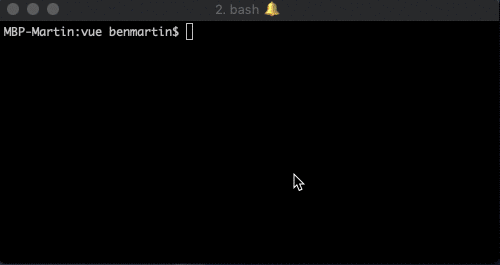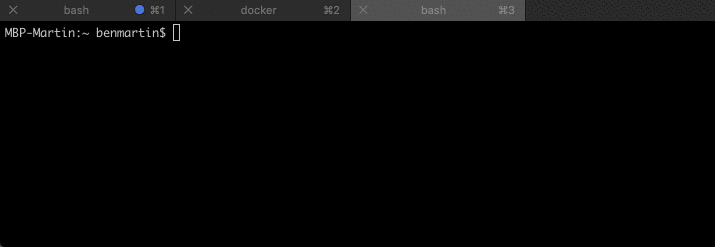By: Benjamin Martin
Let's take a moment to consider what is important for local development. For me, I want to make sure all my developers are using the same dependencies, and I don't want to worry about what versions they have installed. No more "but it works on my machine" excuses. At the same time, I want to make sure we retain the conveniences of HMR (Hot Module Replacement) so that developers don't need to constantly refresh the application to see their changes reflected. We don't want to lose fast feedback.
In this article, we'll look at how we can setup Docker for a boilerplate VueJS app with custom Dockerfiles from which our images and containers will be built and how we gain efficiencies from these.
In case you missed the first part in this series, check here to learn more about the command line interface that Docker ships with. We need to use the commands from that article in this section. If you are already familiar with Docker CLI, please continue to follow along.
Prerequisite: Create our project
This is of course a Docker article, so please ensure you have Docker installed. You can follow the official install instructions for Docker here. Since I'm using Vue, I've used the VueCLI to spin up a quick workspace with vue create docker-demo.
The configuration I selected (seen below) will be relevant to do E2E testing and unit testing which will become part of our CI/CD pipeline.
Once everything is installed, cd into our new project folder, open an IDE and let's dig in.
Custom Docker Image for Development
If you've played with Docker but not built your own image, you probably know we specify an image when we execute our docker run command. Those images are pulled from Docker Hub or some other remote repository (if that image is not found locally). In our case though, we want to build a custom image.
In the root of our project, create a file named Dockerfile.dev. This will be our development image. In that file, copy the following code into it.
# Base Image
FROM node:9.11.1
ENV NODE_ENV=development
ENV PORT=8080
WORKDIR /usr/src/app
COPY package*.json /usr/src/app/
RUN cd /usr/src/app && CI=true npm install
EXPOSE 8080
CMD ["npm", "run", "serve"]
Ok... but what does all this do? Let's dig into it.
Dockerfile Commands and Keywords
FROM specifies the preexisting image on which to build our custom image. Since we are running a node application, we've chosen one of their official Docker images.
FROM node:9.11.1 means our application image will start with the node v 9.11.1 image
ENV sets environment variables
ENV PORT=8080sets the environment variablePORTfor later use
ENV NODE_ENV=developmentsets the environment variableNODE_ENVfor use within our app
WORKDIR sets the working directory within the container
WORKDIR /usr/src/appdefines/usr/src/app/as our working directory within the docker image
COPY copies new files, directories or remote files into the container/image
COPY package*.json /usr/src/app/copies ourpackage.jsonandpackage-lock.jsoninto our working directory
RUN executes a command in a new layer on top of the current image and commits it. When you run the build, you will see a hash representing each layer of our final image
RUN cd /usr/src/app/ && CI=true npm installchanges the working directory to where thepackage.jsonis and installs all our dependencies to this folder within the image. This makes it so that the image holds frozen copies of the dependencies. Our Docker image, not our host machine, is responsible for our dependencies
EXPOSE allows us to access a port on the container from our host machine
EXPOSE 8080matches the port on which our app is running, inside the container and allows us to access our app from our host machine
CMD provides the default initialization command to run when our container is created, like a startup script
CMD ["npm", "run", "serve"]sets this as our default command when we start our container. This is not run when building the image, it only defines what command should be run when the container starts.
I know you're anxious to get this running, but hold your horses. Let's look closer at our Dockerfile.dev and understand why we did what we did.
Dockerfile Structure Recommendations
So, Where's my app?
Right. We didn't use the COPY command to copy our full workspace. Had we done so, we'd need to run docker build and docker run for every code change. We don't want to do this over and over for development. We can be more efficient
Caching Dependencies
We are taking advantage of how Docker layers the images. As Docker builds our image, you'll see a hash for each layer as it is completed. What's more is that Docker also caches these layers. If Docker can see that nothing has changed on that layer from a previous build (and previous layers are also identical) then Docker will use a cached version of that layer, saving you and your developers precious time! When a layer changes, any cached layers on top of it are invalidated and will be rebuilt.
Therefore, if there is no change to our package.json or the package-lock.json then our entire image is cacheable and doesn't need to be rebuilt!
Priority
This is also why you want to have other Dockerfile commands that change less frequently near the top of our file. As soon as one layer of our cache is invalidated, for example, if you change ENV PORT=8080 to another port, that cached layer and every cached layer after it is invalidated and Docker will have to rebuild those layers.
Building the Custom Docker Image
Now, build the image with this command: docker build --tag docker_demo:latest --file Dockerfile.dev .
Using
--tagin thedocker buildcommand allows us to easily reference this image from ourdocker runcommandThe
.at the end of thedocker buildcommand references the context where our customDockerfilecan be found. So, this command should be run from the root of our project directory
You can run it with docker run docker_demo:latest, but unfortunately, we have more work to do to get it working quickly and easily from the command line.
Running our Container: Quality of Life Improvements
We're going to be executing our docker run command daily, if not more frequently. However, if we simply execute the docker run docker_demo:latest command, Docker will create a new container each time. Docker won't stop the old container unless you do so explicitly. This is very useful in many cases, but since we've hardcoded the host port, we'll run into port collisions on our host machine.
In order for us to easily stop and remove our old containers, we should name them so we can easily refer to them later. Additionally, I want the running container to be removed if I cancel the running process.
docker run --rm -it\
--name docker_demo_container\
docker_demo:latest
What was added?
We added a --name field to the end of our run command. This allows us to reference the container without looking up the hash. Now, we can easily stop our container by name.
We also added the --rm and -it flags to our docker run command. The --rm flag tells Docker to remove the container if and when it is stopped. The -it flag keeps the terminal live and interactive once the container is started.
Mounting Host Directories
Let's go back to our docker run command and let's find a way to mount our workspace directory to a folder within our container. We can do this by adding a mount point to our container in the docker run command. This will tell Docker that we want to create an active link between our host machine's folder (src) and the Docker container folder (dst). Our new command should look like this:
docker run --rm -it\
--name docker_demo_container\
--mount type=bind,src=`pwd`,dst=/usr/src/app\
docker_demo:latest
But this could conflict with our host machine's node_modules folder since we're mounting our entire pwd to our app's location in the image (in case one of our developers accidentally runs npm install on their host machine). So, let's add a volume to ensure we preserve the node_modules that exists within our container.
docker run --rm -it\
--name docker_demo_container\
--mount type=bind,src=`pwd`,dst=/usr/src/app\
--volume /usr/src/app/node_modules\
docker_demo:latest
Accessing Ports Inside the Container
If you tried the above command (and you're running a VueJS app), you should see:
App running at:
- Local: http://localhost:8080/
It seems you are running Vue CLI inside a container.
Access the dev server via http://localhost:<your container's external mapped port>/
Docker is giving you a hint that we need to expose a port from our container and publish it on our host machine. We do this by adding the --publish flag to our run command. (We already have the EXPOSE command in our Dockerfile.dev)
--publish <host-port>:<container-port>tells Docker that traffic to the host machine (i.e. via localhost) on port<host-port>should be directed towards the container at the<container-port>that you define.
docker run in One Command
Let's take a look at our final run command:
docker run --rm -it\
--name docker_demo_container\
--publish 4200:8080\
--mount type=bind,src=`pwd`,dst=/usr/src/app\
--volume /usr/src/app/node_modules\
docker_demo:latest
Running the above command will finally allow us to access our app via http://localhost:4200.
Testing it out
Let's build a fresh copy and run it. If you try changing one of our file's templates, you'll see everything is still functioning as it should be.
But speaking of testing, what about unit tests? Well, once our container is running, we can open a new terminal and docker exec a command to run in our container.
docker exec -it docker_demo_container npm run test:unit
The above command will create an interactive terminal connection with our container docker_demo_container and execute the command npm run test:unit in it, allowing us to run unit tests for our app.
In Closing
We now have a way to build our development images and run them locally while maintaining the conveniences of Hot Module Replacement to keep our development workflow efficient. Our developers don't need to worry about dependencies on their host machine colliding with those in the image. No more "but it works on my machine" excuses. And, we also have a command we can easily run to execute our unit tests.
If you find anything I missed or want to chat more about Docker, please reach out to me!








Top comments (1)
The best thing about Docker is that you don't even need a custom Docker image for frontend development.
Before you start the server, one more command is needed:
This way, the
node_modulesdirectory is accessible from the host machine, which means autocompletion inside the IDE. Plus, you don't have to fiddle with theDockerfile.Some comments may only be visible to logged-in visitors. Sign in to view all comments.